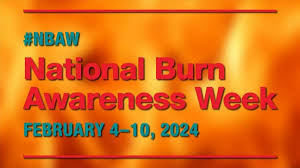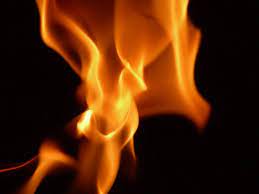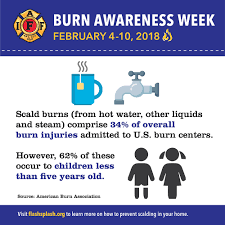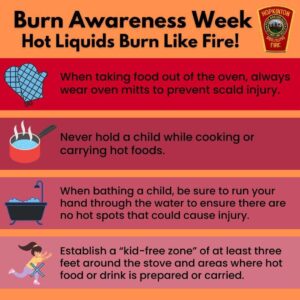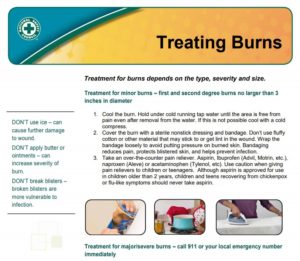This week is National Burn Awareness Week (NBAW) – which is an excellent opportunity to increase burn awareness and prevent fires from occurring! During NBAW, want to bring attention to fire safety and prevention to help lower the number of burn injuries.
Burn Injuries
Approximately every minute, someone in the United States endures a burn injury severe enough to require treatment. Lionel Crowther is one of the many firefighters who was injured while on duty. Crowther responded to what seemed to be a routine garage fire, but within minutes, a flashover occurred. When the fire was cleared, two fire captains had been killed, and Crowther was among four severely injured firefighters.
There are three types of burns:
- First-degree burns are considered mild compared to other burns. …
- Second-degree burns (partial thickness burns) affect the epidermis and the dermis (lower layer of skin). …
- Third-degree burns (full thickness burns) go through the dermis and affect deeper tissues.
- Fourth-degree burns involves injury to deeper tissues, such as muscle, tendons, or bone. This is the deepest and most severe of burns. They’re potentially life-threatening. These burns destroy all layers of your skin, as well as your bones, muscles, and tendons.
Treatments:
As with first-degree burns, avoid cotton balls and questionable home remedies. Treatments for a mild second-degree burn generally include:
- running the skin under cool water for 15 minutes or longer
- taking over-the-counter pain medication (acetaminophen or ibuprofen)
- applying antibiotic cream to blisters
First-degree burns are usually treated with home care. Healing time may be quicker the sooner you treat the burn. Treatments for a first-degree burn include:
- soaking the wound in cool water for five minutes or longer
- taking acetaminophen or ibuprofen for pain relief
- applying lidocaine (an anesthetic) with aloe vera gel or cream to soothe the skin
- using an antibiotic ointment and loose gauze to protect the affected area
Second-degree burns are more serious because the damage extends beyond the top layer of skin. This type burn causes the skin to blister and become extremely red and sore.
Some blisters pop open, giving the burn a wet or weeping appearance. Over time, thick, soft, scab-like tissue called fibrinous exudate may develop over the wound.
Due to the delicate nature of these wounds, keeping the area clean and bandaging it properly is required to prevent infection. This also helps the burn heal quicker.
Some second-degree burns take longer than three weeks to heal, but most heal within two to three weeks without scarring, but often with pigment changes to the skin.
The worse the blisters are, the longer the burn will take to heal. In some severe cases, skin grafting is required to fix the damage. Skin grafting takes healthy skin from another area of the body and moves it to the site of the burned skin.
- Early cleaning and debriding (removing dead skin and tissue from the burned area). …
- Intravenous (IV) fluids containing electrolytes.
- Intravenous (IV) or oral antibiotics if your child develops an infection.
- Antibiotic ointments or creams.
- Raising the injured body part above the heart, if possible.The burn is often black and frequently leads to loss of the burned part. Burns are generally preventable.
- Covering the affected area with a loose bandage or cloth.
- Placing a light sheet or blanket over them, especially if they appear cold from reduced blood pressure.
- Flushing the area with water (for chemical burns only)
Prevention
Unfortunately, Crowther’s story is not uncommon, but with an increased awareness of fire safety and prevention, we can lower the number of fire-related injuries and deaths together. NBAW is the perfect time to learn more about fire prevention and what you can do to prevent and prepare for a home fire.
- Smoke Alarms: Did you know that three of every five fire deaths resulted from fires in homes with no working smoke alarms? Smoke alarms that are properly installed and maintained play a key role in reducing fire deaths and injuries. They should be installed on every floor and in every sleeping room. Be sure to test them once a month and replace the batteries at least once a year.
- Fire Extinguishers: It is also important to have at least one fire extinguisher on every level, especially in the kitchen. In many cases, fire extinguishers are the first line of defense and often contain or extinguish a fire.
- Escape Routes: Ensure that every room has at least two escape routes in case of a home fire. You may need to purchase escape ladders, especially for second story rooms. Escape ladders are not required by law, but they could be beneficial in case of a house fire. Once you establish escape routes, practice at least twice a year.
- Teach: It is essential to teach the whole family about fire safety and what to do in case of an emergency. This includes making an emergency communications plan, knowing where to meet up outside, and making sure everyone knows how to call 9-1-1.
